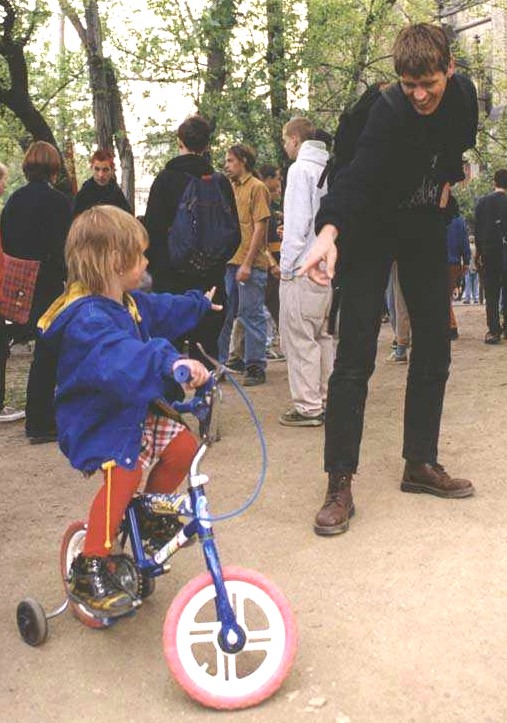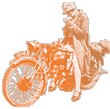 |
Sesame open! - or - Sesame Street?
[ 6.6.2001, Jan Haverkamp
Média > Popkultury
]
For an immigrant into the Czech Republic one of the most wonderful experiences happens daily around seven o`clock in the evening: Vecernicek. Story telling is a Czech virtue. But playing with children also? The American kids` hit "Sesame Street" last year also reached Czech television, but under a different name: "Sesame open!". This name change tells more about Czech attitudes than first meets the eye, i think.
The daily five minutes of Vecernicek (the small evening paper, or the little evening man) for small children are a true delight for me as a 41 year old father. And also for children, obviously, as my six year old daughter drops virtually everything to watch the programme, no matter which serial it brings. At the moment it is "Hugo", the big snow-man caught up in Czech communist reality. For me the most wonderful series are still the little mole "Krtcek". But also a "life" series as the one about three young bears growing up in a photographer`s family was wonderful. Even half a year after, my daughter Bara sometimes hums the lead melody of this programme.
Also "pohadky" - fairytails - are a hit. Often 90 minute long features come every weekend, and around Christmas there is nothing nicer than laying with the whole family on a big bed watching at least 5 of the 15 broadcasted full feature fairy-tale films. Almost all circling around princesses. The faces of many an actress in the Czech Republic (including that of first lady Dagmar Havlova) are well known by children as... princess. The story plots are often only slightly moralist, the costumes wonderful, and the emotions can sweep you away. The only thing one should not do, is look at them with a politically correct mind-set. Gender roles are heavily consolidated (with the exception of sometimes a strongly minded princess here and there), as are class roles (even within productions made before 1989) and the use of violence (though not shown, often strongly implied). "But who cares," insist my Czech friends. "It`s only fairy tales."
Czech television has a lot to bring to children - in the story-telling field. But i have a different feeling with children`s participative programmes. And there are quite a lot: Girafa, Dada and so on. What i notice there is a strong mirorring of the Czech infantalising attitude towards children. It first appears in the language - there is a special type of Czech language used by adults towards children. I guess that will be in other languages as well, but in Czech it is very obvious: the tone of voice of the adult raises at least half an octave when starting to talk to kids, and the tone under it become strongly paternalistic (also in case of women). It seems that the fast development in adult-child relations that coincided with the second feminst wave also past the Czech borders. As such, children in the North/West have only been recognised as such really around halfway the 18th century. A breakthrough that ackowledged the special position of children in society. A breakthrough not the least pushed by Czech educator Jan Amos Komensky (Comenius). This special attention to children slowly degraded to making them "second class citizens" in the early 20th century, however. The resulting "you are only children, so shut up" mentality came under fire in the seventies, when older children started demanding more attention for their own opinions, and parents giving more attention towards younger children as partners in life, rather than subordinate know-nothings. In many Western European and (North and South) American countries, this development was reflected in children`s TV programmes. A few examples: the best news programme in the Netherlands is already for some decades the so called "Youth News" (Jeugdjournaal). A bit more positive than the adult news, a lot clearer, but still ground-breaking, open, a real "adult" news programme for kids from as young as six to eighteen.
Another programme that really won me over was "Sesame Street". The original US version is replacing a lot of holes left behind by a failing school system in the United States, concentrating on reading and counting things. The Dutch version, however, is already over 25 years a complete children`s world. A real street, with real inhabitants. Besides the original Sesame Street characters like Bert and Ernie, the Dutch version introduced Ieniemienie the Mouse, Tommy the dog, its own version of Big Bird (Pino), and a lot more, as well as several real people: Mr. Aart - a negative nudging old man who in the end still sees that he was maybe wrong, Sien - a black mother/sister figure with a huge amount of wisdom, Hakim - a North African clown with a very fine sense of emotion. Sesame Street in the Netherlands is Life. It does not have a mission, it does not have a message, it is. You can imagine my high expectation when it was announced two years ago or so, that CT1 was to bring a Czech version of Sesame Street. But it needs more than only a creative basis of the original idea. It needs obviously a cultural surroundings to be able to make a creativity triggering feature for children. This was already reflected in the name of the programme: "Sesam, otevrete se!" instead of the more logical "Sesam ulice". It translates with "Sesam open!" - the sentence from the fairy tales from 1001 Nights that also was the original basis for the name of Sesame Street. Sesame Street was to be a real today childrens` version of the world in mount Sesame. The street aspect was very important in this. Bert and Ernie`s is not a fairy tale world. It`s the real kids` world but in a clownesk, puppet, colourful setting. With emotions, with language, with reading and counting, with geography, with music - and in several countries like the Netherlands in its adapted version - with everyday recognisable and livable life. That was obviously one step too far for Czech adult TV makers. Sesame Street was put back to the level of story telling and basic language and counting. No breakthrough. Just more of Dada and Girafa...
Come to think of it - the great story telling is maybe very fundamental in Czech culture. Think of its writers, think of the talk in the pub over a beer. Where story-telling used to create a living link between the generations, it seems to have developed into a way of... getting out of reality. Or maybe... easyness. "I tell you a story - you just listen"... and stop thinking about today`s reality. Maybe children programmes tell more about a society than meets the eye?
More information on Sesame Street: http://www.sesamestreet.com
A taste of the Dutch version can be found by going to the Dutch broadcaster`s Website NPS and press number "9" in the menu on the left hand side: it will give you access to the start-films of 25 years of Sesamstraat.
| Jan Haverkamp is of Dutch origin and immigrated into the
Czech Republic in 1997. He worked as organizational development specialist
for Central and Eastern European environmental organizations and is
currently Greenpeace anti-nuclear campaigner for Central Europe. Besides that he is facilitator in the ZHABA facilitators collective. He lives with
his partner and daughter in Cvrcovice
near Kladno and has a son in the Netherlands. |
 |
Názory
z druhé strany - Thought from the other side
In
this weekly column, pro-feminist men - men that are strongly influenced
by the feminist movement - write their observations in daily life on the
role of men and women in the Czech Republic.
|





